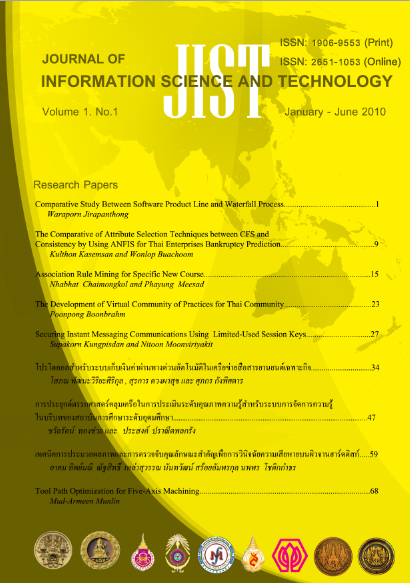Application of Fuzzy Logic in Knowledge Quality Assessment for Knowledge Management Systems in The Context of Institutions of Higher Education
Main Article Content
Abstract
- This research aims to adopt the principles of Fuzzy Logic that applied to assess the quality of knowledge in knowledge management systems in the context of institutions of Thailand higher education. This research use both qualitative and quantitative methods. The research methodology follows the three main steps: 1) survey and analysis of criteria to measure quality of information 2) Find the method how to measure the quality of knowledge in knowledge management systems in higher education such as universities which based on expert’s opinion 3) to assessment the quality of knowledge in knowledge management systems with Fuzzy Logic and Analytic Hierarchy Process. The research shows that with our proposed knowledge quality metric and knowledge assessment method is more reliable than the traditional knowledge management systems assessment.
Article Details
This work is licensed under a Creative Commons Attribution-NonCommercial-NoDerivatives 4.0 International License.
I/we certify that I/we have participated sufficiently in the intellectual content, conception and design of this work or the analysis and interpretation of the data (when applicable), as well as the writing of the manuscript, to take public responsibility for it and have agreed to have my/our name listed as a contributor. I/we believe the manuscript represents valid work. Neither this manuscript nor one with substantially similar content under my/our authorship has been published or is being considered for publication elsewhere, except as described in the covering letter. I/we certify that all the data collected during the study is presented in this manuscript and no data from the study has been or will be published separately. I/we attest that, if requested by the editors, I/we will provide the data/information or will cooperate fully in obtaining and providing the data/information on which the manuscript is based, for examination by the editors or their assignees. Financial interests, direct or indirect, that exist or may be perceived to exist for individual contributors in connection with the content of this paper have been disclosed in the cover letter. Sources of outside support of the project are named in the cover letter.
I/We hereby transfer(s), assign(s), or otherwise convey(s) all copyright ownership, including any and all rights incidental thereto, exclusively to the Journal, in the event that such work is published by the Journal. The Journal shall own the work, including 1) copyright; 2) the right to grant permission to republish the article in whole or in part, with or without fee; 3) the right to produce preprints or reprints and translate into languages other than English for sale or free distribution; and 4) the right to republish the work in a collection of articles in any other mechanical or electronic format.
We give the rights to the corresponding author to make necessary changes as per the request of the journal, do the rest of the correspondence on our behalf and he/she will act as the guarantor for the manuscript on our behalf.
All persons who have made substantial contributions to the work reported in the manuscript, but who are not contributors, are named in the Acknowledgment and have given me/us their written permission to be named. If I/we do not include an Acknowledgment that means I/we have not received substantial contributions from non-contributors and no contributor has been omitted.
References
2. Nonaka, I. “A dynamic theory of organizational knowledge creation,” Organization Science, 5(1), p. 14–37, 1994.
3. Devenport, T.H., D.W.D., Long & Beers, M. “Successful Knowledge Management Projects,” Sloan Management Review. 39(2): p.43-57, 1998.
4. Nonaka, I. & Takeuchi, H. “The knowledge creating company. How Japanese companies create the dynamics of innovation”, New York: Oxford University Press, 1995.
5. Philip B. Crosby, Quality Is Still Free: Making Quality Certain In Uncertain Times, 2nd Edition, McGraw-Hill Companies, 1995.
6. W. Edwards Deming and Mary Walton, The Deming Management Method, 1st Edition, Perigee Books Publication, 1988.
7. พยุง มีสัจ, ผศ.ดร. “ระบบฟัซซีและโครงข่ายประสาทเทียม,” คณะเทคโนโลยีสารสนเทศ มหาวิทยาลัยเทคโนโลยีพระจอม เกล้าพระนครเหนือ, 2551. Online available:http://202.44.34.134/teacher/FileDL/phayung36255212212.pdf เข้าถึงเมื่อ: 25 ตุลาคม 2552.
8. เกียรติสุดา นาคประสิทธ์ิ, ดร. “ตรรกศาสตร์วิภัชนัย :Fuzzy Logic,” คณะวิทยาศาสตร์ มหาวิทยาลัยขอนแก่น, หน้า 22-27. มปป.
9. วิฑูรย์ ตันศิริคงคล, “AHP กระบวนการตัดสินใจที่ได้รับความนิยมมากที่สุดในโลก” กรุงเทพฯ : กราฟฟิค แอนด์ ปริ๊นติ้ง, หน้า 55, 2542.
10. สุธรรม อรุณ, “การตัดสินใจโดยใช้กระบวนการลำดับชั้นเชิงวิเคราะห์” Process management (Vol.64)_1, สำนักวิชาวิศวกรรมศาสตร์ มหาวิทยาลัยนเรศวร วิทยาเขตสารสนเทศพะเยา, มปป.



